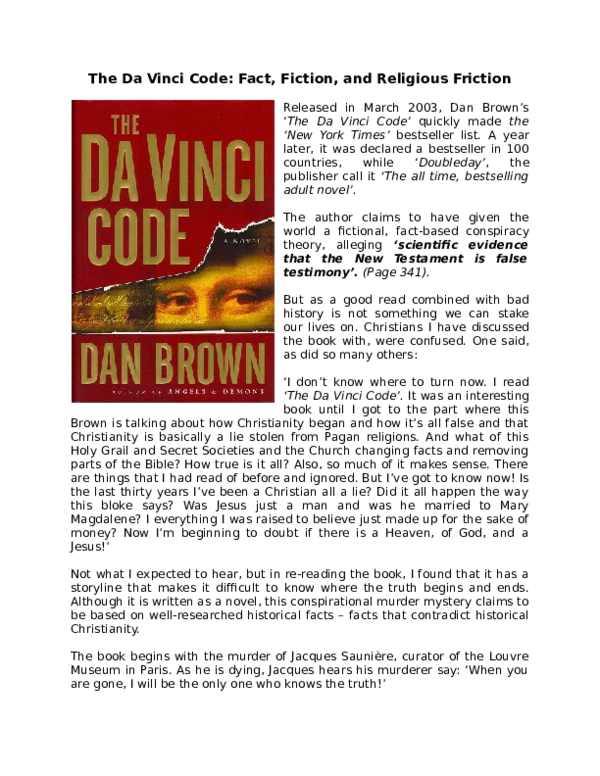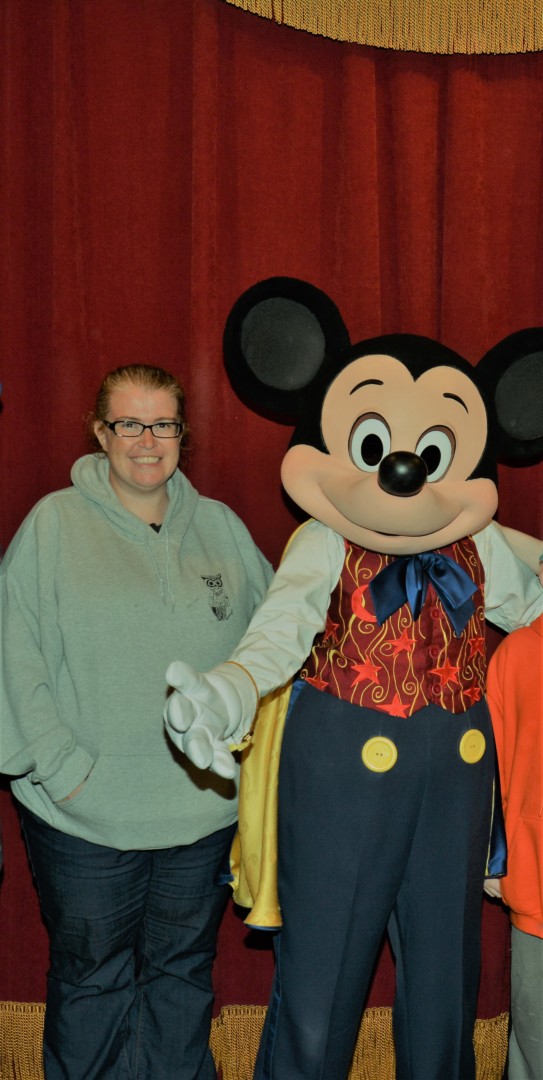The Da Vinci Code: Fact Vs. Fiction In Dan Brown's Bestseller

Table of Contents
The Priory of Sion: Myth or Reality?
A key element in The Da Vinci Code is the Priory of Sion, a secretive society allegedly protecting ancient secrets. The novel portrays the Priory as a powerful organization with a long history, influencing major historical events and safeguarding the truth about Jesus Christ and Mary Magdalene. However, the historical existence of the Priory of Sion as depicted in the book is highly questionable.
-
The Priory of Sion's origins and early history: While a real Priory of Sion existed, its history is far less dramatic than Brown's portrayal. Its origins trace back to a religious order founded in the 12th century, unrelated to the secretive society in the novel. The modern iteration of the Priory, linked to the fictional narrative, emerged much later and its claims are largely unsubstantiated.
-
Analysis of its alleged members and their influence: The Da Vinci Code names several prominent figures as members of the Priory, including Leonardo da Vinci and Isaac Newton. However, there's no credible historical evidence to support these claims. The alleged influence of the Priory on significant historical events is purely fictional.
-
The historical evidence supporting and refuting the Priory's existence and role: The historical evidence for the fictionalized Priory's activities is extremely weak. Serious historians dismiss the claims made about its influence and membership as fabrications. The existence of the Priory itself, as portrayed in the novel, is largely a product of 20th-century hoaxes and conspiracy theories.
-
How Brown's portrayal differs from historical accounts (if any): Brown's depiction of the Priory of Sion is a significant departure from any historical accounts. He takes liberties with historical facts to create a compelling narrative, but this fictionalization should not be mistaken for reality. The Da Vinci Code Priory is a completely different entity from the historical religious order of the same name.
The Holy Grail: Fact, Legend, and Fiction
The Holy Grail, a central motif in The Da Vinci Code, has multiple interpretations, ranging from a literal chalice used by Jesus at the Last Supper to a symbolic representation of spiritual enlightenment. The novel blends these various interpretations, creating a unique and controversial portrayal.
-
Religious interpretations of the Holy Grail and its symbolic meaning: In Christian tradition, the Holy Grail holds immense religious significance, often symbolizing the cup used during the Last Supper, or sometimes the blood of Christ. However, these are largely symbolic interpretations with limited historical evidence.
-
The Grail's presence in medieval legends and their influence on Brown's novel: Medieval legends surrounding the Grail often depict it as a magical object with extraordinary powers, influencing Brown's depiction. The novel draws inspiration from these legends to create its fictionalized narrative of the Grail's true identity.
-
The novel's interpretation of the Grail and how it departs from traditional understandings: The Da Vinci Code offers a radical reinterpretation of the Grail, portraying it not as a physical object but as a metaphor for Mary Magdalene and her bloodline, significantly departing from traditional Christian understandings.
-
Discussion of alternate theories and interpretations surrounding the Grail's identity: Numerous theories surround the Grail's true identity, ranging from literal interpretations to symbolic ones. Brown's novel selectively draws upon these theories to craft its narrative, further blurring the line between historical fact and fictional interpretation. The Da Vinci Code Holy Grail should be viewed as a work of fiction, not historical fact.
Historical Figures: Fact and Fictional Portrayals
The Da Vinci Code significantly alters the historical portrayal of key figures like Mary Magdalene and Jesus Christ, sparking considerable debate.
-
Analysis of Mary Magdalene's historical role and Brown's interpretation: While Mary Magdalene was a significant figure in the early Christian church, the novel presents a highly romanticized and fictionalized version of her role. It portrays her as Jesus's wife and the carrier of his bloodline, a claim unsupported by historical evidence.
-
Examination of the historical evidence concerning Jesus Christ's life and family: The historical record concerning Jesus Christ's life is limited, but existing accounts don't support the claims made in The Da Vinci Code. The depiction of Jesus's marriage and family is entirely fictional.
-
Comparison of the novel's depiction of these figures with historical accounts and scholarly research: Scholarly consensus strongly refutes the novel's portrayal of Mary Magdalene and Jesus's relationship. The book's account presents a highly embellished and imaginative interpretation of established historical data.
-
Discussion of the impact of these fictionalized portrayals on public perception: The fictionalized portrayals in The Da Vinci Code have significantly impacted public perception of these historical figures, leading to ongoing discussions about historical accuracy and artistic license in fictional narratives.
The Role of Art and Symbolism
Leonardo da Vinci's art plays a crucial role in The Da Vinci Code, with Brown weaving symbolism and hidden meanings into the narrative.
-
Analysis of specific works by da Vinci and their interpretation in the novel: The novel draws heavily on da Vinci's paintings, such as The Last Supper and the Mona Lisa, reinterpreting their symbolism to support its fictional plot. These interpretations are frequently debated amongst art historians.
-
Examination of the symbolism employed in these works and how Brown integrates them into the plot: Brown meticulously incorporates the symbolism present in da Vinci's art, using it to create clues and red herrings within the narrative of The Da Vinci Code. He connects artistic imagery to the larger themes of the novel.
-
The connection between the art and the narrative's central themes: Da Vinci's art serves as a visual foundation for the novel's central themes, reinforcing the plot's mystery and intrigue. The connection between the artwork and narrative elements is carefully constructed.
-
A critical assessment of Brown’s interpretation and its accuracy: While Brown's interpretation of da Vinci's artwork is imaginative and engaging, it's frequently disputed by art historians. His interpretations are often viewed as subjective and not necessarily aligned with established scholarly views.
Conclusion
This article examined the intersection of fact and fiction in Dan Brown's The Da Vinci Code, analyzing the novel's historical claims and their basis in reality. While the novel's plot is entirely fictional, it sparked conversations about history, religion, and the power of interpretation. We dissected the myths, legends, and historical figures interwoven into the narrative, highlighting the discrepancies between Brown's interpretation and established historical knowledge.
Understanding the difference between fact and fiction in The Da Vinci Code allows for a richer appreciation of the novel's impact and its contribution to popular culture. Further explore the history and symbolism behind The Da Vinci Code to fully understand its complex layers. Do your own research – delve deeper into The Da Vinci Code's fascinating blend of historical fact and fictional intrigue!

Featured Posts
-
 Dzherard Batler Luchshie Roli I Filmy Po Mneniyu Zriteley
May 13, 2025
Dzherard Batler Luchshie Roli I Filmy Po Mneniyu Zriteley
May 13, 2025 -
 Chris Packhams Support For The Hug A Slug Campaign A Look At The Best Sex Show On Earth
May 13, 2025
Chris Packhams Support For The Hug A Slug Campaign A Look At The Best Sex Show On Earth
May 13, 2025 -
 Sabalenka Challenges Umpire Photo Evidence In Stuttgart Victory
May 13, 2025
Sabalenka Challenges Umpire Photo Evidence In Stuttgart Victory
May 13, 2025 -
 Gibraltar Industries Earnings Preview Key Financial Metrics To Watch
May 13, 2025
Gibraltar Industries Earnings Preview Key Financial Metrics To Watch
May 13, 2025 -
 Angela Swartz Key Facts And Insights
May 13, 2025
Angela Swartz Key Facts And Insights
May 13, 2025
